The Italian word ‘antipasto’ (plural antipasti) can be translated to ‘before the meal’ and refers to a platter of food traditionally served – you guessed it – before meals in Italy. Usually accompanied by wine, this pre-meal platter is comparable to French hors d’oeuvres and Spanish tapas in that it is an appetiser designed to stimulate the appetite prior to the main course. But what goes on an Italian antipasto platter?
While there are a few traditional characteristics of the food served as part of an antipasto platter, there’s no reason why you can’t add your own twist. As owners of many authentic Italian restaurants in Milton Keynes, we’ve put together this article not only to explain what an antipasto platter is but also to help you gain an understanding of what is typically put on one, as well as some ideas for putting your own unique flair on this cultural dish.
Delicious Italian Antipasto Platter Ideas
At our authentic Italian restaurants in Wolverton and surrounding areas, we offer a tastebud-tantalising antipasto misto – ‘misto’ referring to mixed pieces of meat and vegetables. Consisting of parma ham, spianata picante, chorizo, grana padano, smoked cheese, olives, artichokes and homemade bread, it is truly the perfect platter to share and enjoy in anticipation of your main course. Our antipasto platter was carefully designed by our expert chefs, using smoky and salty flavours to pique your senses, maximising your ability to appreciate the tastes and textures of your following dishes.
While our antipasto platter is fairly traditional, there is no reason why you can’t add non-traditional elements to a homemade antipasto platter. If you would like to try your hand at making one but aren’t sure where to start, read on for our suggestions for antipasto arrangements designed to suit various dietary preferences, from meaty-heavy platters to fully vegan ones!
- What Is An Antipasto Platter?
- What Goes On An Antipasto Platter?
- Italian Antipasto Platter Ideas
- How To Arrange An Antipasto Platter
Ready For More Tastebud-Tantalising Tips?
Sign up for our newsletter here!
What Is An Antipasto Platter?
So, we’ve established that an antipasto platter is a selection of foods traditionally served prior to the main course in Italy. But what goes on an antipasto platter? The variety of foods served as part of this Italian appetiser tends to include meats, seafood, cheeses, breads and fruits. The foods included in these arrangements tend to share a few characteristics: typically, they are served cold, divided into small pieces that are easy to eat with the hands, and have a strong flavour that will stimulate the senses. Antipasti are traditionally beautifully and delicately arranged, either on one central serving platter or on a series of smaller plates.
What Goes On An Antipasto Platter?
As mentioned above, antipasti typically include a variety of different foods. While you can put anything you like on an antipasto platter, the traditional components include sliced cured meats, fruits such as grapes and olives, crunchy and soft breads, and a variety of soft and hard Italian cheeses. Antipasti platters should be well balanced in colour, texture, flavour and nutrition: not only do they look and taste amazing, but they provide a variety of nutrients for a satiating yet moreish appetiser that prepares the palate for the main courses. Try to keep this in mind when preparing your antipasto platter!
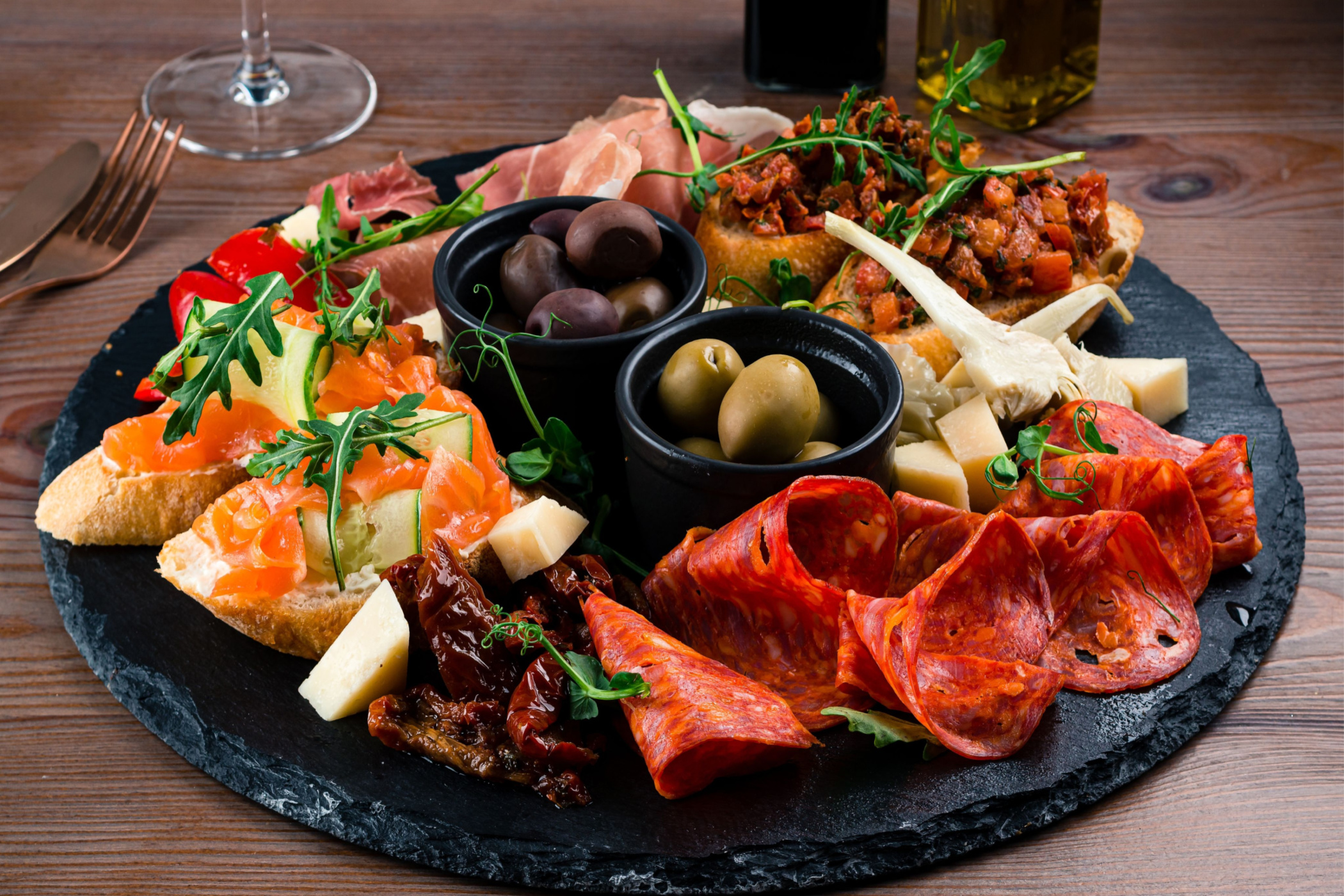
Italian Antipasto Platter Ideas
Now that we’ve established what an antipasto platter is, as well as what goes on one, we thought we’d provide you with a few ideas for when it comes to actually putting one together. What you put on your antipasto platter will depend on the dietary requirements of you and your guests, so we’ve devised a guide to creating platters that cater to meat-lovers, vegetarians, and vegans alike.
Vegetarian Antipasto Platter
If you or any of your dinner party guests are vegetarian, you can still create a delicious antipasto platter without meat. You can choose to stick to the traditional antipasto components and simply exclude the meat, or you can substitute it in a number of ways. Here are our favourite vegetarian antipasto platter ideas to provide you with some inspiration:
Meat Substitutes
In order to keep to traditional antipasto components, why not simply swap cured meats for vegetarian substitutes? This way, you can enjoy all the same smoky, salty flavours without the meat. Whether you choose to try your hand at making your own vegetarian and vegan-friendly salami from scratch or simply buy sliced meat alternatives from the supermarket, you can absolutely create a traditional antipasto, vegetarian style!
Cheeses
Should you choose to exclude meat and meat substitutes from your antipasto, your platter will need a new focus. One direction you could take this in is cheese. While a meat-heavy antipasto may just feature a few small wedges or slices of cheese, if you make the dairy product the main focus of your platter, you could include miniature wheels of cheese for your guests to help themselves to as they please. From soft mozzarella to hard Italian cheeses, try to include a variety of textures of cheese – just remember to double-check that they are vegetarian since hard Italian cheeses are usually, but not always, made with rennet.
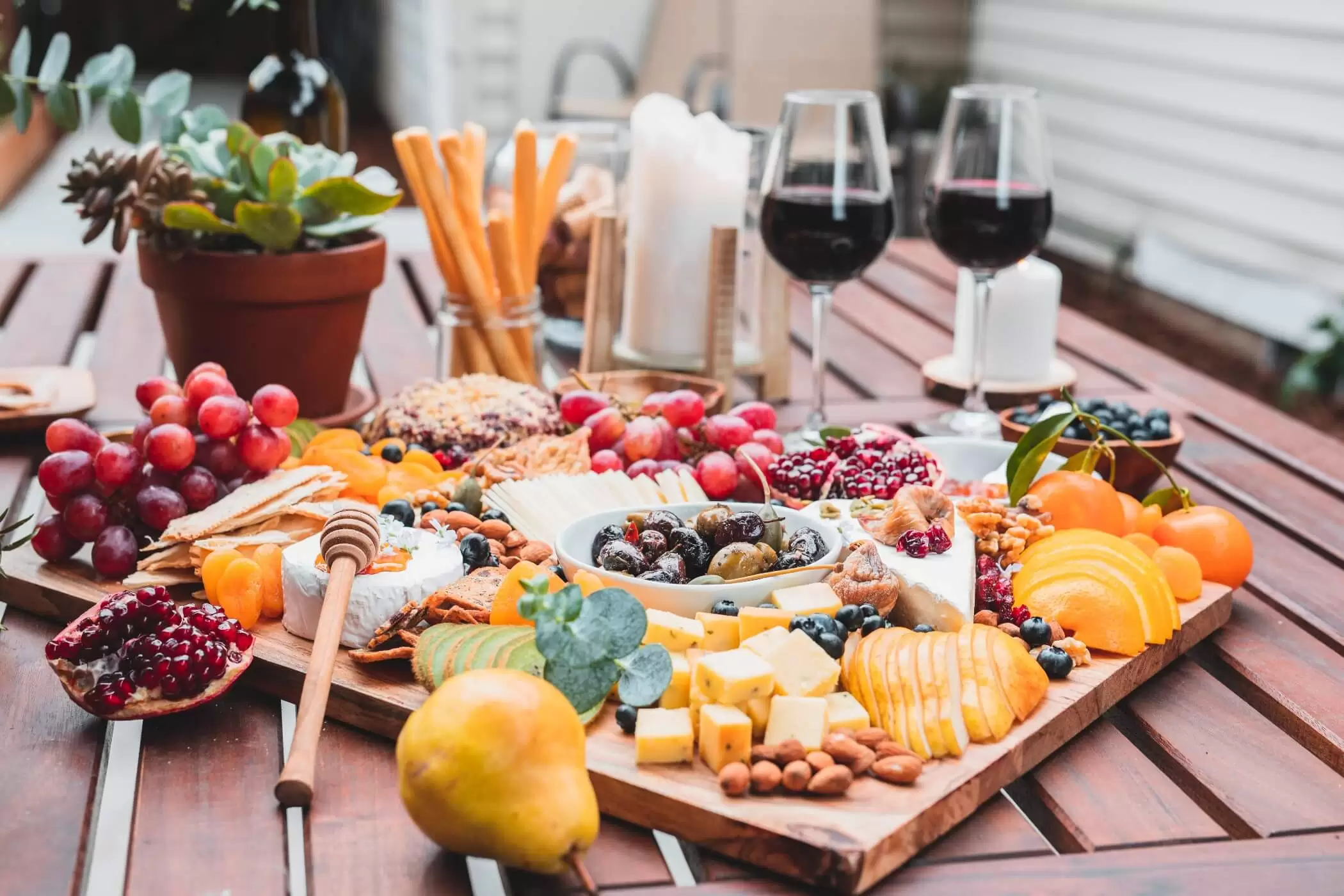
Vegan Antipasto Platter
Since the main components of a traditional antipasto, i.e. meats and cheeses, are animal products and therefore not vegan, you may be concerned that a vegan antipasto would consist of a sad mix of rabbit food. Thankfully, this doesn’t have to be the case! Here are our favourite vegan antipasto platter ideas:
Meat And Cheese Substitutes
If you want to create a traditional antipasto platter that is vegan-friendly, you can absolutely do this by simply substituting meats and cheeses for vegan alternatives. As mentioned before, you can try your hand at making these yourself or buy them from your local supermarket or online. Take a look at Vegan Food And Living for 23 homemade vegan cheese recipes, ranging from simple tofu feta to a creamy baked vegan goat’s cheese.
Hummus
Although hummus is a Middle Eastern dip rather than an Italian one, it pairs beautifully with a variety of breads, olives and other fruits, all of which you may choose to include on your vegan antipasto platter. While traditional hummus, be it store-bought or homemade, is an excellent choice for your platter, you could also consider making one of the hummus recipes on Live Kindly, which include a tempting roasted garlic hummus, as well as a smoked paprika one.
Pickled Fruits And Vegetables
Pickled fruits and veggies have a strong, tangy flavour, making them the perfect thing to include in your vegan antipasto appetiser. Pickled onions will work beautifully, as will cucumbers, carrots, peppers, and, of course, olives. While sundried tomatoes aren’t technically pickled, they also have a deliciously rich and tangy flavour and will work beautifully with the other components of your antipasto platter. Not only this, but they will also add a gorgeous pop of colour to the dish!
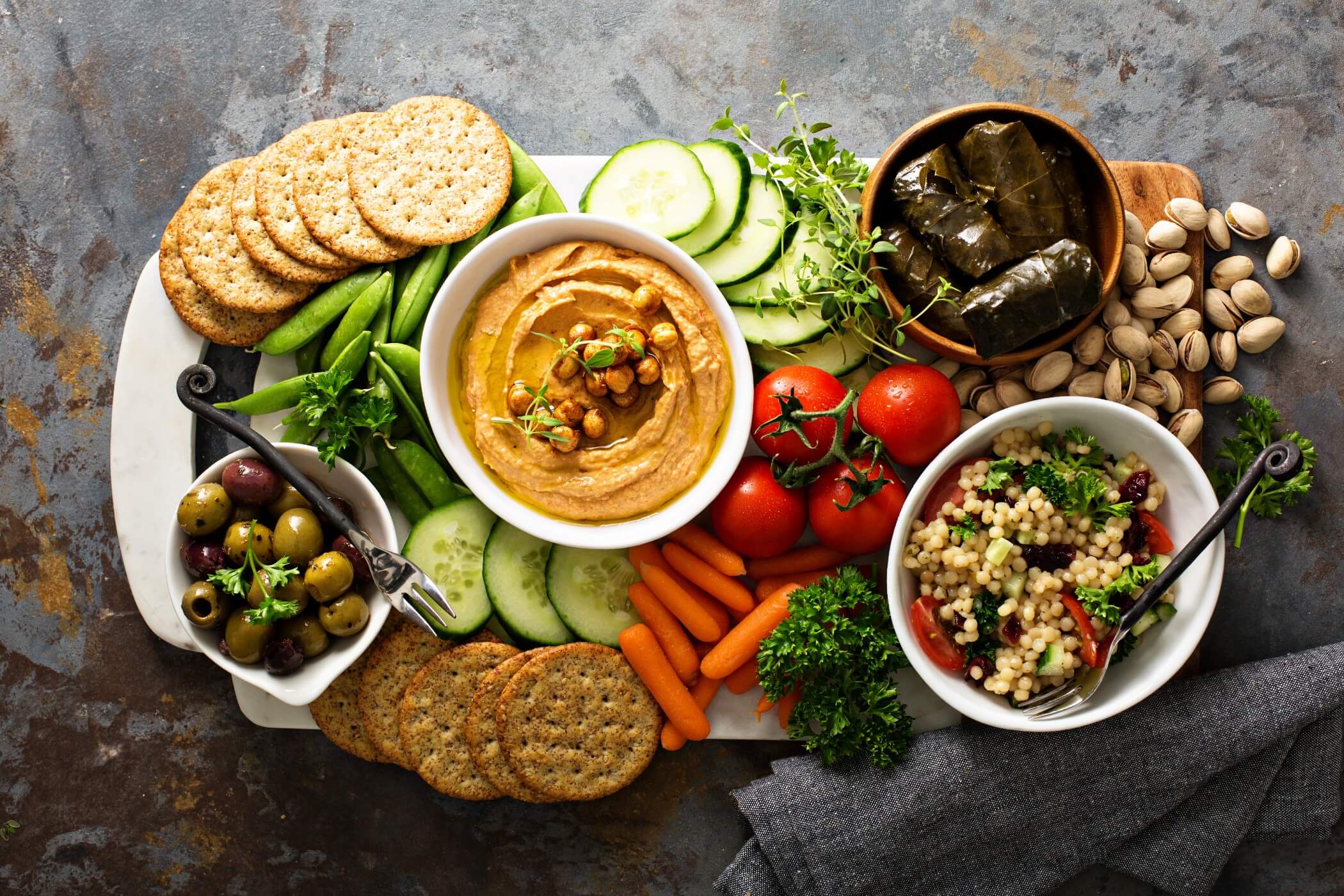
Meat Antipasto Platter
An antipasto platter is a perfect thing to serve to any meat-loving guests that you host for a dinner party. Since antipasti are usually served cold, you will be able to prepare it in advance and simply serve it straight from the fridge once your guests arrive. This way, you will buy yourself plenty of time in the kitchen to prepare the main course while your guests enjoy your equally stunning and delicious concoction. Here are some ideas of what to put on a meat antipasto platter:
Cured Meats
Cured meat refers to any meat that has been preserved through smoking, salting, brining, canning, ageing, or drying. These processes not only prevent the growth of bacteria on the meat over time, but some of them, such as salting, brining and smoking, add flavour to the meat. These strong flavours are perfect for an antipasto platter. Common cured meats include salami, chorizo, pepperoni, bacon, pancetta, and parma ham.
Typically, a meat antipasto platter will include three or four different types of cured meats, which will either be sliced thinly and artistically draped on the plate or cut into thicker rounds and neatly stacked, depending on the type. This way, the platter looks aesthetically pleasing and is easy to eat using fingers. The meats can also be easily paired with different cheeses, fruits, and breads, allowing for a large variety of different flavour combinations.
Meat Pairings
Should you choose meat as the focus of your antipasto platter, you will naturally need to think carefully about which meats will provide the best variety and combination of flavours, as well as produce an attractive-looking platter. However, you should not neglect to carefully consider which meat pairings to include. By this, we are referring to the cheeses, fruits and breads that make up the rest of the platter.
Your meat pairings can truly make or break your platter, so it is vital that you don’t just blindly and randomly select a few kinds of cheese to go with your cured meats. Instead, take a look at the handy guide to pairing meats and cheese over on Serious Eats. Similarly, Veroni offers some invaluable advice when it comes to selecting dried and fresh fruits to complement your cured meats. Finally, check out Eat With Drink With for guidance on bread that pairs well with different meats and cheeses. Whichever pairings you choose for your meats, don’t neglect to include olives, which arguably belong on any antipasto, thanks to their deliciously tangy, salty flavour!
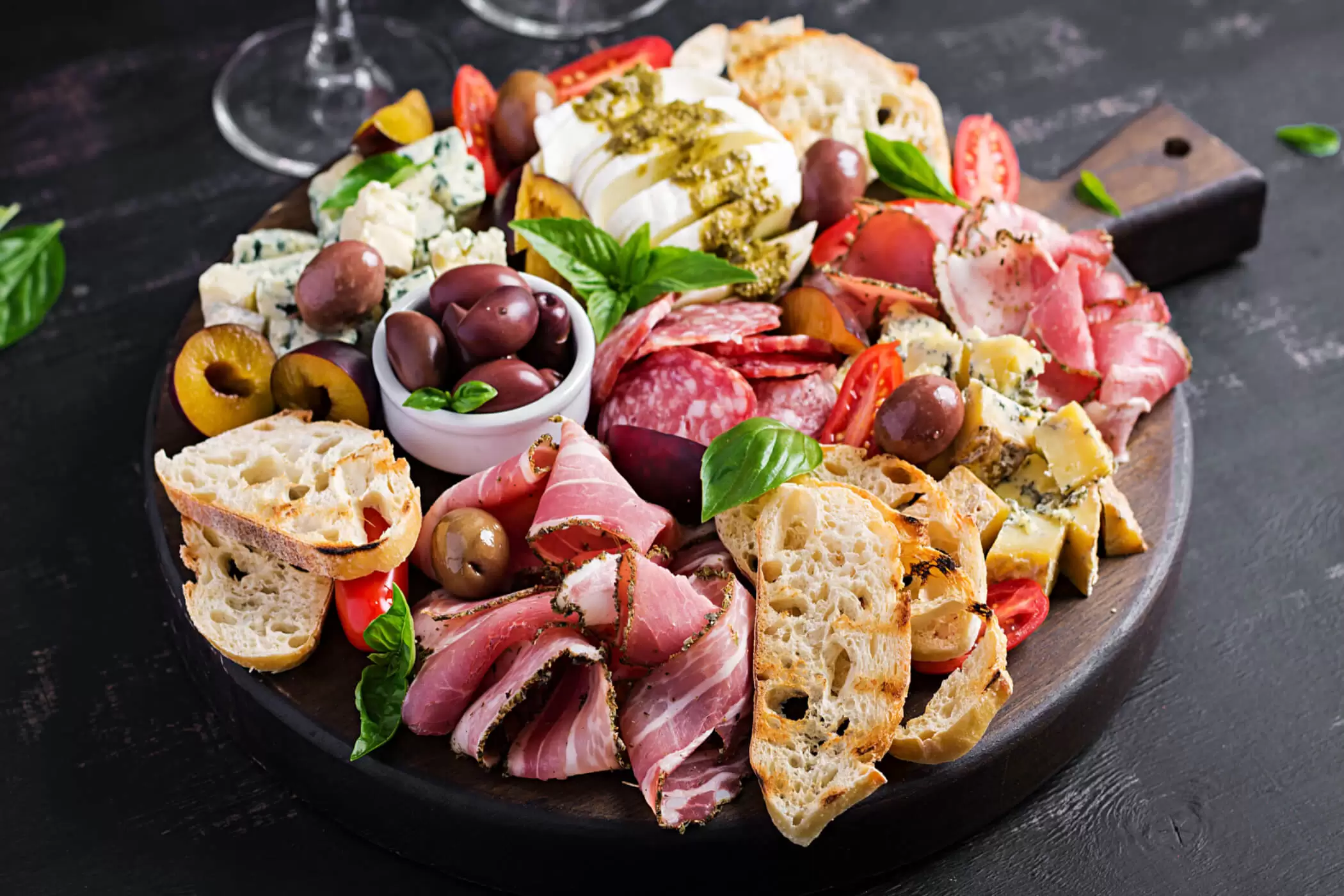
How To Arrange An Antipasto Platter
Arranging your antipasto platter nicely is the perfect way to make it look extra appetising! If you’re looking for ideas on how to do this in a way that looks good and provides the best eating experience, check out our tips on how to arrange an antipasto platter below:
- Use bowls – any messy, oily, or especially moist components of your platter can be placed into bowls to prevent it from becoming a soggy mess. Bowls should be placed on the platter first, and other components arranged around them.
- Put complementary foods together – make sure that your guests fully appreciate the flavours that your platter has to offer by placing complementary foods together, making it easier to pair them.
- Explore shape, size and colour – don’t be afraid to be adventurous when it comes to the shape, size and colour of your components. Varying these factors will add interest to your platter, so consider chopping some components up small and leaving others large or whole.
- Choose your serving board carefully – there’s no point in beautifully arranging your different antipasto components if the serving board you’re using looks cheap and tacky! We recommend serving your platter on an elegant artisanal chopping board.
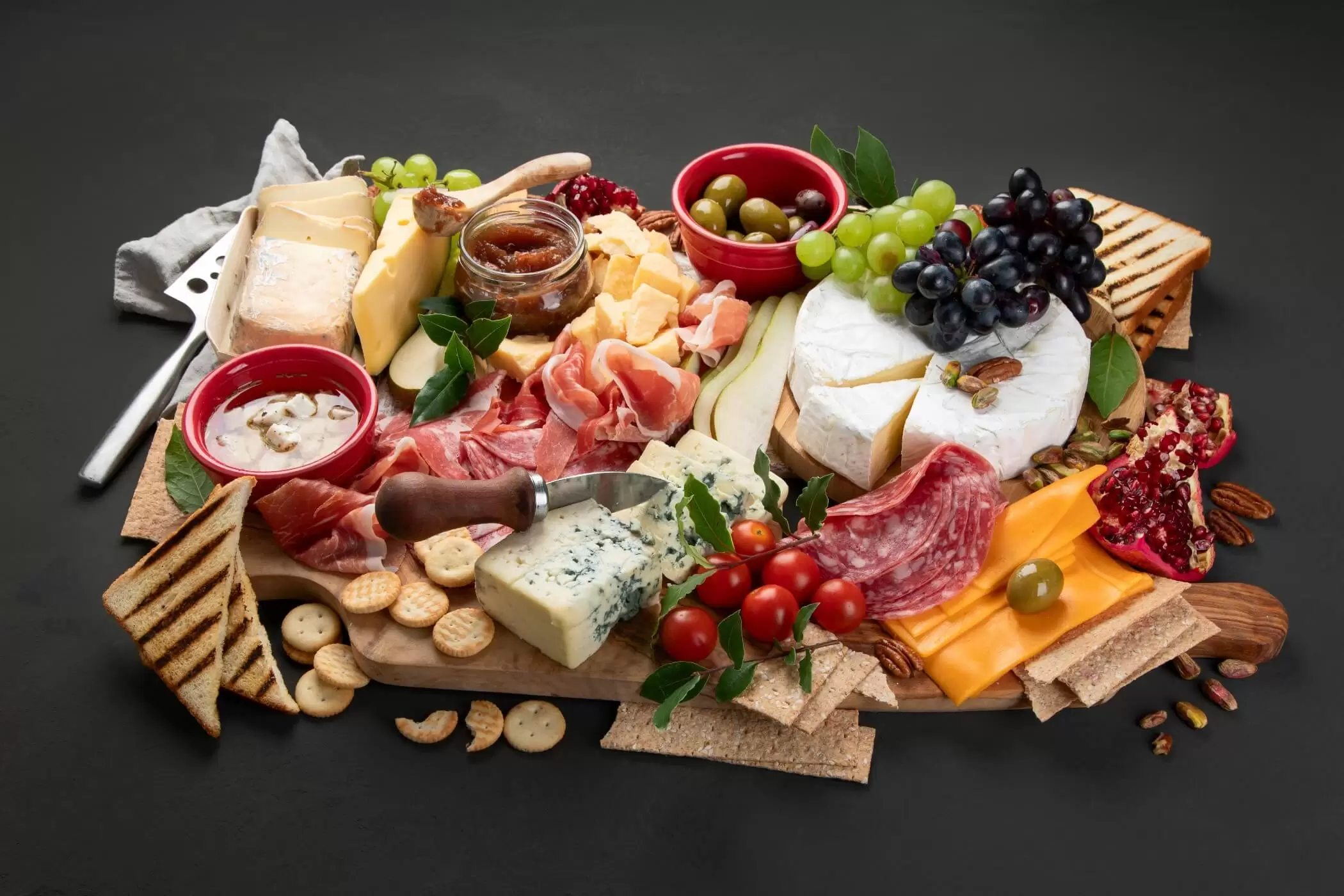
Making The Perfect Antipasto Platter
Can you picture anything more tastebud-tantalising than the thought of a deliciously fresh and tangy antipasto platter served in the summer just before dinner? We certainly can’t! Hopefully, with the help of our tips for making the perfect Italian antipasto platter, be it meat-loaded, vegetarian or vegan, you will be able to recreate this perfect vision yourself! Alternatively, you could always bring your family and friends down to one of our restaurants in Milton Keynes to try our incredible antipasto misto. All of our dishes are prepared each day freshly using traditional methods, meaning that you’ll get a true taste of Italian cuisine!
Have Any Questions For Us?
Leave your details here to get in contact with our team.

